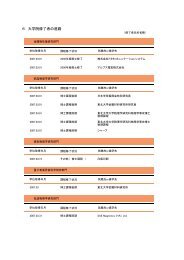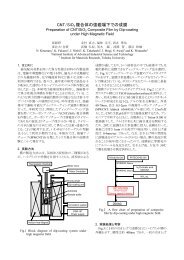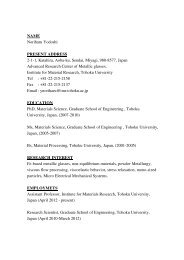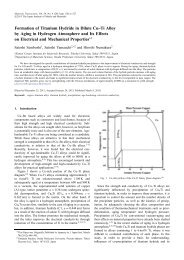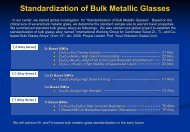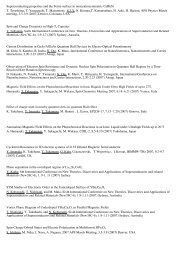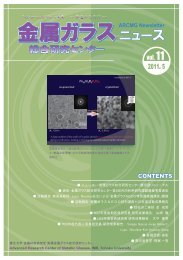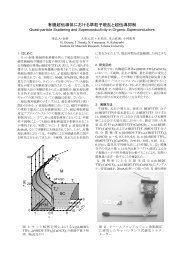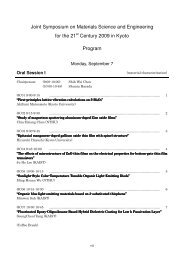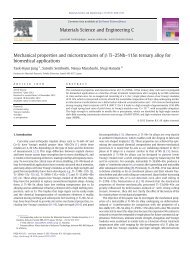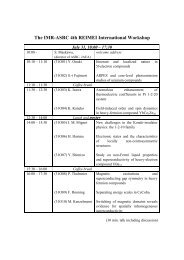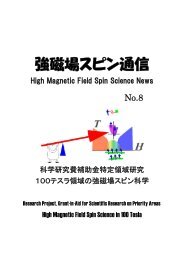ARCMG Newsletter - éå±ã¬ã©ã¹ - æ±å大å¦
ARCMG Newsletter - éå±ã¬ã©ã¹ - æ±å大å¦
ARCMG Newsletter - éå±ã¬ã©ã¹ - æ±å大å¦
Create successful ePaper yourself
Turn your PDF publications into a flip-book with our unique Google optimized e-Paper software.
金 属 ガラス 総 合 研 究 センターニュース Vol. 14<br />
attract increasing attention because they have many<br />
interesting characteristics such as high mechanical<br />
strength and corrosion resistance that aree different from<br />
those of crystalline alloys due to the non-periodicity<br />
of<br />
their<br />
atomic arrangement. However, sincee the initiation<br />
and propagation<br />
of shear bands take place almost<br />
simultaneously,<br />
monolithic BMGs exhibit only limited<br />
plasticity due to the formation of highly localized shear<br />
bands under loading. The extent of the plastic deformation<br />
in the BMGs depends on the total amount of shear bands<br />
generated during<br />
deformation. Therefore, plasticity of the<br />
BMGs could be improved by generating a large number of<br />
shear bands and impeding their sudden propagation. Thus,<br />
the concept of constructing<br />
a heterogeneous<br />
microstructure by<br />
introducing<br />
secondary phases withinn a<br />
glassy matrix was adopted to improve plasticity of the<br />
BMGs. The in-situ formation of reinforcement during<br />
preparation of the composite<br />
has been thought to be<br />
effective for good wettability<br />
between dispersoids and<br />
matrix as well as homogenous<br />
dispersion of<br />
reinforcements. In this study, Zr-Al-Ni-Cu<br />
BMG matrix<br />
composites containing nitride ceramic particles were<br />
prepared by introducing particulate Al/AlN<br />
composites as<br />
starting materials. The microstructure of f the composite<br />
reinforced with ZrN particles and their mechanical<br />
properties were investigated.<br />
A Zr-Ni-Cu pre-alloy ingot was prepared by arc-melting<br />
pure<br />
metals in a Ti-gettered argon (99.999%) atmosphere.<br />
Subsequently, a mixture of the pre-alloyed ingot and<br />
Al/AlN composites (37 % volume fraction<br />
of AlN) was<br />
re-melted in the arc-melting furnace. BMG matrix<br />
composites with the matrix composition of Zr55Al10Ni5Cu<br />
u30,<br />
which is a well-known Rapidly<br />
solidified specimens were prepared by<br />
re-melting the composite alloys in quartz tubes and<br />
ejecting with an over-pressuree of 50 KPa through a nozzle<br />
onto a Cu wheel rotating with a surface velocity of 40 m/s.<br />
high glass forming alloy, were<br />
prepared.<br />
Cylindrical samples of 1-3 mmm in diameterr and 50mm in<br />
length were obtained by suction casting in a water cooled<br />
copper mold. The<br />
morphology<br />
and microstructure of the<br />
in-situ synthesized Zr BMG/ZrN compositee were observed<br />
by scanning microscopy (SEM; JSM6360, JEOL). Phase<br />
composition of the composite was characterized by X-ray<br />
diffraction analysis (XRD; New<br />
D8 advance, Bruker) using<br />
monochromatic Cu Kα radiation for a 2θ range of 20-800 o .<br />
The elastic modulus was obtained from ultrasonic<br />
measurement and<br />
the density of<br />
the compositee was determined<br />
using<br />
the Archimedes’ method.<br />
Fig. 1 shows the<br />
XRD resultss of the as-spun ribbons and<br />
the master alloy.<br />
The mass fraction of the starting AlN<br />
particles in the composite was 1.7 wt. %. It was found that<br />
the pattern of the<br />
composite ribbon sampless was composed<br />
of a halo pattern<br />
and diffraction peaks, indicating the<br />
coexistence of glassy and crystalline phases. It should be<br />
noted that the diffraction peaks are not assigned to the<br />
AlN phase but to the ZrN phase in both<br />
of composite<br />
ribbon and master alloy sample. These results r indicate<br />
that chemical reaction(Zr + AlN → Al + ZrN) occurred<br />
during the arc melting.<br />
Fig. 1 XRD patterns for (a) Zr55Al10Ni5Cu30 ribbon; (b) Zr<br />
BMG/ZrN composite ribbon; ; (c) Zr BMG/ ZrN composite<br />
masterr alloys<br />
Fig. 2 shows a SEM imagee of cross-section of as-cast<br />
composite containing 4 vol.% ZrN. The ZrN<br />
particles under<br />
10 μm sizes are homogeneoush<br />
sly dispersed in BMG matrix.<br />
EDS analysis revealed that the bright spherical particles<br />
were ZrN and the grey massive domain surrounding s<br />
the<br />
ZrN<br />
particles were Zr-Al-Ni-Cu metallic glass.<br />
Fig. 2 SEM micrograph of in-situ formed ZrN reinforced<br />
Zr-based BMG composite<br />
Fig. 3 shows mechanical properties of as-cast monolithic<br />
BMGs and composite<br />
with 1 mm diameter. The<br />
compression fracture strength of the Zr BMG/ZrN<br />
composite was about a 2.1 GPa, being higher than thatt of<br />
the Zr BMG (about 1.7 GPa). . It is also worth noting that<br />
the BMG composite showed improved plasticity before its<br />
fracture. In addition, a slightly serrated plastic flow was<br />
also<br />
observed inn the plasticc deformation<br />
region of the<br />
stress–strain curve. These results suggest that multiple<br />
shear bands were formed during plastic deformation.<br />
These improved mechanical properties attributed to the<br />
fine,homogeneously dispersedd ZrN particles in the BGM<br />
matrixeously dispersed ZrN particles in the BMG matrix.



